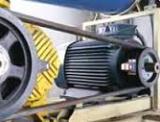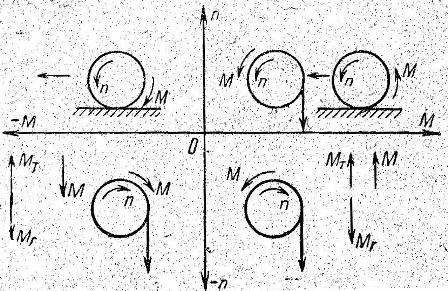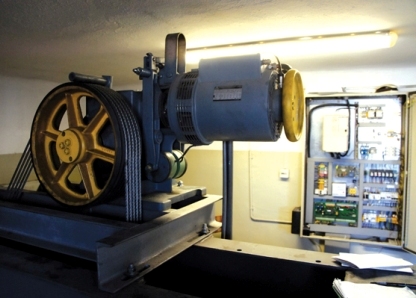The main modes of operation of the electric motor in the electric drive system
 A complete picture of the operation of any electric drive motor is given by examining the mechanical characteristics plotted in four quadrants of a rectangular coordinate system (Fig. 1). These characteristics correspond to two main modes of operation of the electric motor: motor and brake.
A complete picture of the operation of any electric drive motor is given by examining the mechanical characteristics plotted in four quadrants of a rectangular coordinate system (Fig. 1). These characteristics correspond to two main modes of operation of the electric motor: motor and brake.
Motor mode is called such mode of operation of the electric motor, in which the latter drives the working mechanism. In braking mode, the driving force is the mechanism and the motor either balances this force or slows down.
Depending on the operating mode, the direction of the torque and the speed of rotation change. For the positive directions of the rotation speed and torque of the electric motor, take:
1) with vertical movement — the direction of rotation of the electric motor when lifting the load and the torque for the case of the electric motor working to lift the load,
2) with horizontal movement, for example, for different types of carts, one of the directions of movement of the mechanism (forward, right) and the torque developed by the motor corresponding to this movement. The moments overcome by the motor in this case will be negative.

Rice. 1. Image of drive motor operating modes in rectangular coordinate axes
As you can see from fig. 1, in the first quadrant of the coordinate system, the electric motor operates in the motor mode (for example, when lifting a load or moving a cart). The second quadrant corresponds to the mode of operation of the electric motor during horizontal movement of the mechanism with braking, when the electric motor creates a braking moment that opposes the movement of the shaft of the mechanism.
The third quadrant considers the case of the electric motor operating in light load lowering, when the load moment cannot overcome the frictional moment in the mechanism and gears, and the electric motor helps to lower the load, developing a motor torque that matches the direction of motion of the load, but opposite in sign to the moment when the load is lifted.
Finally, the fourth quadrant refers to the case of motor rotation under the influence of an external torque. This mode can occur, for example, when lowering heavy loads, when the electric motor develops a braking torque, holding the load and preventing the speed of the lifting mechanism from increasing. In this case, the motor torque has a positive sign, since it is directed in the same way as when lifting.

